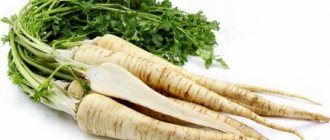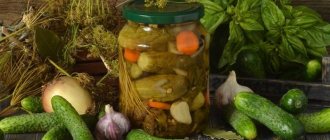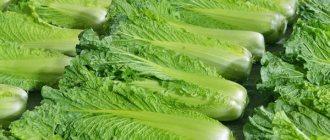Preparation Optimal conditions Timing and methods
You can find useful information on how to store savoy cabbage, Chinese cabbage, Brussels sprouts, kohlrabi, broccoli and cauliflower on our website.
Harvesting rules for long-term storage
The timing of harvesting white cabbage depends on the variety, growing region, and weather conditions. Varieties suitable for storage:
- mid-season - growing season 130-135 days, stored for 3-4 months;
- medium-late - ripen in 140 days, retain taste for up to six months;
- late ones - grow for 150 days or more; in suitable conditions, shelf life is 8-9 months.
In central Russia, cabbage is harvested from the second half of September to the third ten days of October. In the climatic conditions of Siberia and the Urals, where night frosts begin early, harvesting begins in the first ten days of September.
Before harvesting, you need to make sure the cabbage is ripe, since ready-made forks last longer and dry out less. Signs of a ripe head of cabbage:
- the plant has stopped developing;
- the fork is dense, its surface is smooth and shiny, when squeezed the leaves emit a characteristic crunch;
- the covering leaf plates acquire a bluish tint;
- the lower leaves turn yellow.
The optimal temperature for harvesting vegetables is +4-6°C. Harvesting in hotter weather reduces shelf life. Short-term frosts are not dangerous for cabbage, but at night frosts from -6°C and below, the forks freeze and become unsuitable for storage. If the cabbage is frozen, you need to leave the crop standing for 4-5 days, allowing the heads of cabbage to thaw completely.
They stop watering cabbage 2 weeks before the expected harvest date. Choose a sunny day without precipitation. Depending on the storage method, the cabbage is carefully dug up with a shovel or cut with a sharp knife or chopped with a hatchet. At least three covering leaves and a stump 4-5 cm long are left on the head of cabbage.
Variety selection
What varieties of white cabbage are suitable for storage? To store white cabbage, you need to choose late and late-ripening varieties:
- Wintering 1474 – very resistant to frost. The rosette is large with small leaves. Round-flat heads of cabbage, weight up to 3.5 kg. High sugar content. Virtually no cracking. Excellent shelf life up to 8 months. Suitable for northern regions;
- Albatross F1 is a representative of late-ripening hybrids. The fruits are round-flat, dense, average weight 3 kg. During winter storage, it is resistant to diseases and white rot;
- Alaska F1 is a late hybrid. The head is round, gray-green, and has a short stump. The weight is small, only 1.8 kg, and can remain in the garden for a long time due to its resistance to freezing;
- The gift is a dense, light green, glossy head of cabbage, flat-round in shape. Suitable for fermentation. Cabbage is cold-resistant and can be grown in Siberian conditions;
- Moscow late is a very productive and large-fruited variety. Head weighing up to 8 kg, sometimes up to 13 kg. The fruit is round green, ideal for pickling;
- Kolobok F1 is late-ripening. The heads are dense, do not crack, and have a fairly short stump. The color of the cabbage is green on top and white when cut. Practically not susceptible to disease and rot. Excellent keeping quality;
- Guarantor F1 is a more oval-shaped head of cabbage, gray-green on the outside, yellow in cross section. The taste is excellent. Can be stored until June;
- Morozko - a round-flat head of cabbage is well covered with large green leaves. Resistant to cracking. Keeping quality is excellent, can be stored until the next harvest;
- Sugar loaf - the variety is valued for its taste, but can be stored fresh only until the New Year;
- Kharkov Winter is the latest ripening variety. The average weight of heads of cabbage is up to 3 kg. It tolerates heat and cold well during growth.
You can find out which cabbage varieties are suitable for long-term storage from the video:
Selection of root crops and preparation for storage
After harvesting, the heads of cabbage are washed with running water, if they are dirty, and if possible, cleaned of slugs hiding in the lower part of the head. The forks are placed under canopies or in a dry, ventilated room to dry and ventilate the cut area for 12-24 hours.
You cannot leave cabbage in the beds - direct sunlight will cause the upper leaves to wither. For cut forks, lowering the temperature even to -1°C is critical; exposed tissue easily freezes.
Fully ripe, firm heads are suitable for long-term storage. Rejected:
- cracked, loose, not fully formed heads of cabbage;
- heads with mechanical damage;
- leaves affected by insect pests;
- forks with signs of rot on the fork or stump;
- vegetables with frozen leaves.
Late-ripening varieties have the best shelf life, which can be recognized by their dense heads with coarse veins.
Which varieties and hybrids are suitable for winter storage
Successful cabbage storage begins with choosing the right variety. Mid- and late-ripening heads of cabbage can survive the entire winter. Based on my experience, I have identified the most suitable varieties and hybrids, which can be found in the table below.
I rate the success of storage on a 10-point scale. If the head of cabbage has lain until the end of spring and has not spoiled, then it receives a maximum score of 10 points. Cabbage, which has lost its attractive appearance already in November-December, receives only 1 point.
Table − Assessment of the success of cabbage storage by variety
| Variety | Storage success | Note |
| Amager | 4 | Lost its juiciness, after February a slight bitterness appeared |
| Aros F1 | 5 | Sourish smell from December |
| Snow White | 7 | Color changed during storage |
| Turquoise plus | 5 | Mold has penetrated inside the head of cabbage |
| Brunswick | 7 | Lost its juiciness in March |
| Snowstorm | 8 | Lost her attractive appearance in April |
| Hannibal F1 | 8 | Small spots of mold appeared on all the heads of cabbage in the spring. |
| Hermes F1 | 5 | Strong odor that other foods in the refrigerator have begun to absorb |
| Dauerweiss | 9 | Has shrunk a little |
| Dumas F1 | 4 | Yellowed inside and outside |
| June | 1 | Faded quickly |
| Cossack F1 | 3 | We managed to save it only until October |
| Kamenka F1 | 5 | Dried out quickly |
| Stone head | 9 | Specific taste, but fits well |
| Kolobok F1 | 5 | There has been an unpleasant smell since December |
| Crewmont F1 | 8 | Has dried up by spring |
| Malachite | 4 | Dried out quickly |
| Megaton F1 | 6 | The upper foliage has dried out greatly |
| Vixen | 10 | Has a specific taste |
| Morozko | 6 | Turned yellow |
| Moscow late | 9 | Only the edges of the top sheets have dried out |
| Present | 8 | The top leaves have turned yellow and dried out. |
| Rinda F1 | 10 | Excellent result |
| Rusinovka | 5 | Mucus appeared in winter |
| Sugarloaf | 10 | Juicy and tasty until the month of May |
| Slava 1305 | 7 | The top sheets have turned black |
| Stolichnaya | 9 | 1 head of cabbage out of 27 has spoiled |
| Dot | 5 | Managed to keep it juicy until December |
| Harvest | 4 | Mukor quickly appeared |
| The final | 5 | Mucus appeared |
| Extra F1 | 7 | In April, the top sheets were damaged by mold |
Where and how to store fresh cabbage
There are many ways to keep vegetables fresh for a long time. For cabbage, the optimal storage temperature is from 0°C to +2°C, relative air humidity is 85-95%.
Such conditions allow the vegetable to retain its vitamin value and taste for a long time. Forks are periodically inspected and are not stored together with other vegetables. Heads of cabbage that begin to deteriorate are put into processing.
In the ground
To dig trenches, choose a place on a hill where melt water will not accumulate. They dig a ditch 60-70 cm deep and about half a meter wide. The bottom of the pit is lined with straw. The heads of cabbage are laid in two rows, covered with straw on top, and covered with a layer of earth about 20 cm.
When cold weather sets in, the storage facility is additionally insulated with fallen leaves or covered with snow. The storage method is suitable for late varieties of cabbage. Getting heads of cabbage out in the middle of winter is problematic.
In the cellar or basement
The room should not be infected with fungi and mold; the absence of rodents is important. The presence of supply and exhaust ventilation ensures a balanced gas composition of the air: 80% oxygen, 20% carbon dioxide.
On shelves
The cellar is equipped with shelves at least 20 cm wide. Forks are placed on the shelves with the stalks facing up, wrapped in paper or polyethylene.
Hanging
If there is not enough space in the cellar, self-tapping screws are screwed into the ceiling of the storage room. Vegetable stumps are tied with a strong rope and hung upside down. The heads of cabbage should not touch each other.
In a fur coat made of clay
The heads of cabbage are soaked for a day. Prepare a mash of water and clay with the consistency of thick sour cream (ingredient ratio 2:1). Each fork is coated with a clay mixture, dried in the sun, and placed on shelves. Clay prevents rotting and maintains a stable temperature and humidity of the head of cabbage.
In boxes or boxes
The heads of cabbage are placed in wooden or cardboard containers in one layer. The cabbage forks should not touch each other.
In sand
The stalk of the cabbage is cut off, the cabbage is laid in one layer, and a layer of sand is made. Then the next row of forks is laid, covered with sand and soil on top. It is better to use river or washed sand that does not contain organic impurities.
In cling film
The heads of cabbage are tightly wrapped in several layers of food-grade polyethylene. The created vacuum does not allow air and moisture to pass through, extending the shelf life.
On a bed of sand
Dry sand is poured into the boxes in a layer of 20 cm. The forks are installed vertically, sticking the stalks into the ground.
In a bucket with soil
The cabbage is dug up with roots and cleared of soil. The plant is placed vertically in a bucket, sprinkled with soil, and lightly compacted. During storage, the plant is watered once a month.
In paper
The forks are wrapped in several layers of paper and placed in boxes or on shelves, making sure that the paper does not get wet. It is not recommended to use newspapers; printing ink contains harmful substances that fall on the upper leaves.
In a refrigerator
Cabbage is stored in the refrigerator in the vegetable compartment, where the temperature is maintained at a level of +1 to +3°C. Without packaging, cabbage does not last long; after 3-5 days, the cabbage begins to wither and darken. By wrapping the forks in cling film, you can extend the shelf life to 10-30 days.
Small, dense heads are selected, wrapped several times in cling film or placed in a bag, releasing the maximum amount of air, smoothing out the folds of the packaging. Some housewives pre-pack the cabbage in paper and then place it in a bag. The paper is changed when it becomes damp.
In the freezer
Quick freezing to -18°C allows you to store cabbage for 9-12 months. The cabbage is washed, cut into pieces or shredded, the stalk is not used. Large pieces are wrapped in 2-3 layers of cling film.
Chopped cabbage is packaged in plastic containers or bags for freezing food. The semi-finished product is used for cooking without defrosting.
Benefits of frozen cabbage:
- long storage period;
- preservation of 70% of vitamins and nutrients;
- The product is suitable for quick cooking.
After defrosting, cabbage loses its attractive appearance and loses its ability to crunch.
On the balcony
This method of storing cabbage is suitable if you have a glazed, insulated balcony or loggia. The vegetable can withstand light frosts down to -2°C. If the temperature drops below, or its sharp changes are observed, the vegetable loses its elasticity, and the vitamin composition deteriorates sharply. If the temperature conditions are observed, cabbage can be preserved for 4-6 months.
The balcony is equipped with cabinets with shelves and doors. The heads of cabbage are wrapped in cling film and placed in one row. Forks can be stored in wooden boxes with holes provided for air access. The heads of cabbage are placed in boxes in 2 layers and turned over periodically. To reduce the processes of rotting and withering, forks are dusted with chalk or slaked lime.
How growing conditions affect subsequent storage
The success of preservation depends not only on the variety, but also on agricultural technology and weather conditions. List of factors that have a negative impact:
- Excess water leads to premature spoilage of vegetables, this is especially noticeable after a rainy summer. You should also water as needed. Otherwise, cabbage becomes susceptible to various diseases.
- Irregular watering is reflected in the appearance: the heads of cabbage crack, which means they do not last long.
- Excess nitrogen fertilizers have a bad effect on taste and shelf life.
- Those grown on loams are stored longer than those grown on sand.
This vegetable is prone to various diseases, especially rot. Therefore, when growing, you need to ensure that the water does not stagnate. The soil around needs to be loosened. Use both organic and ready-made complex fertilizers. Nitrogen should be given according to the norm until the moment when the head of cabbage begins to set. Phosphorus-potassium can be used throughout the season.
Storage conditions and periods - summary table
| Conditions | Shelf life (months) |
| In earthen trenches | 7-8 |
| In the basement/cellar | 9 |
| In a refrigerator | 1-2 |
| In the freezer | 9-12 |
| On the balcony | 4-6 |
| Dried | 12 |
The indicated values are valid for crops of late varieties, provided that the vegetable is properly harvested and storage conditions are observed.
Which cabbage should not be chosen for storage?
In addition to the variety, when choosing cabbage for storage, I pay attention to several other factors. You should not try to save a head of cabbage for the winter if it:
- not fully formed;
- damaged by pests such as slugs or caterpillars;
- loose to the touch;
- affected by a disease caused by fungi or bacteria;
- has mechanical damage received during assembly;
- caught by frost;
- has cracks or other defects.
Damaged heads of cabbage lie very poorly. They must be rejected and consumed first. I throw away cabbage that is severely damaged by diseases without sparing, so as not to infect other heads of cabbage and poison myself.
Head of cabbage affected by mold
How else can you store cabbage in winter?
Substandard heads of cabbage can be put to good use. There are many recipes for using cabbage as homemade preparations for the winter.
Sauerkraut
During the cooking process, the vegetable undergoes fermentation, resulting in a product rich in vitamin C, containing extremely beneficial probiotics for the body. Sauerkraut strengthens the immune system, improves gastrointestinal function, and strengthens the cardiovascular system.
For fermentation, wooden barrels, enamel containers without chips and glass jars are used. The cabbage is chopped, carrots and salt are added, compacted, and placed in a warm place to start the fermentation process. The finished product is stored in a cool place. Cabbage is fermented with the addition of carrots, cranberries, apples, and spices - dill, caraway, bay leaves.
Cabbage in marinade
To prepare the product, use 9% table vinegar, which can be replaced with citric acid, apple or wine vinegar. The cabbage is chopped, and other ingredients are added if desired: bell peppers, carrots, apples, cranberries.
Prepare the marinade: add salt, sugar and vinegar to taste, pepper and cloves to the water. Bring the liquid to a boil and cook for 5-10 minutes. Cabbage is poured with hot or cold marinade. When poured hot, cabbage can be eaten the same day. Store the marinade in jars under nylon lids in the refrigerator. In a closed container, cabbage can be stored for up to 3-4 months.
Canned cabbage
A variety of salads and snacks are prepared from the vegetable with the addition of bell and hot peppers, tomatoes, onions and carrots. Preservation is used as a dressing for cabbage soup or borscht. Combine shredded cabbage with vegetables and mix. Vegetables are poured with marinade, to which sugar, salt and vinegar are added to taste, and spices.
The jars are covered with metal lids and sterilized in boiling water: 0.5 liter jars - 20 minutes, 1 liter - 30 minutes. Then the lids are rolled up. The preparations can be stored indoors at room temperature.
Dried
Once dried, cabbage retains most of its vitamins and nutrients. Place the finely chopped vegetable on a baking sheet lined with parchment paper. The oven is heated to a temperature of 50-100°C, the door is kept slightly open during drying.
Ready cabbage has a pale yellow tint and does not release juice when squeezed. Store dried vegetables in glass jars with lids, paper bags or linen bags.
The product can be stored for more than a year provided there is no mold, which can appear when the vegetable is not dried sufficiently or there is high humidity in the room.
Storage methods in the apartment
There are no conditions suitable for cabbage in the apartment; if you leave the vegetable in the kitchen, even under the sink, you can be upset after a week. Large volumes of harvest cannot be preserved in such a microclimate, but 2-3 forks can be saved, at least for several months. Various devices are used for this.
In a refrigerator
This is the most reliable way to store cabbage in an apartment. In special boxes, the optimum temperature and humidity for the cabbage is maintained. True, there are fluctuations in these parameters, and therefore the forks will not last as long as we would like - a month or two. You can increase this period if you wrap each head of cabbage in cling film, so the cabbage will be stored for 3-4 months. Periodically it needs to be inspected and the fading leaves should be picked off. Cauliflower and Brussels sprouts cannot be stored this way; they spoil from the cold and become stale.
The second option is freezing. Freeze pre-chopped blanched or fresh cabbage. In this form, the vegetable can be stored for up to a year, but the taste is seriously deteriorated. In addition, cabbage changes color, ceases to be crispy, is more suitable for preparing first and second courses, and is not suitable for salads.
If you choose to freeze, divide the cabbage into portions. She does not like systematic freezing/thawing, so portion freezing is preferable.
Storage in a thermal box
Cabbage will not lie on a balcony or loggia - it will either rot or freeze. However, here you can put a thermal box, made by yourself or bought in a store. The second option is preferable - the device is equipped with a thermostat and can maintain the set temperature inside, even when it is -30 °C outside.
The principle of storing cabbage in a thermal box is the same as in a cellar. The cabbage is pre-wrapped in paper or cling film and placed with the stalks facing up. Depending on the size of the thermal box, you can hide up to 10-15 heads of cabbage and store them until spring. The only condition is that once a month you need to carry out an audit, removing spoiled copies.
Do not wrap cabbage in newspapers - the lead contained in the paint can be absorbed by the leaves and accumulate in them. It is better to use paper napkins, towels, and cling film.
In the storerooms
In apartments of old construction, until approximately the second half of the 60s of the last century, storage rooms were provided. They were located near the front door or under the window sill and were a niche closed with doors. You can also store white cabbage here, but it is first wrapped in cling film, from under which the air is expelled.
Remember that pantries are not a substitute for a refrigerator or basement. Vegetables are stored worse here; after 2-3 weeks they may be unsuitable for food.
Dried
If there is a lot of cabbage, then it is better to dry it for storage in the apartment. At the same time, all nutrients are preserved, and the product can be used to prepare a variety of dishes.
You can dry cabbage in the following way:
- Grind, place on a baking sheet, placing parchment paper underneath.
- Preheat the oven to 50-100 °C.
- Place the baking sheet inside and leave the door slightly open.
Readiness can be determined by the color and condition of the cabbage - it turns pale yellow and does not release juice when squeezed. At the same time, it should not break.
You can store dried white cabbage in glass jars or fabric bags for 1-2 years. The main thing is that the product does not become moldy. This may be due to insufficient drying or due to high humidity in the room.
Causes of premature spoilage
Only mid-late and late varieties of cabbage are suitable for long-term storage. The key to the safety of vegetables is compliance with harvesting rules. The vegetable should be well dried, a few covering leaves should be left on the fork, and the stalk should be 5 cm long.
Before storing vegetables, preventive maintenance is carried out: 500 grams of bleach is dissolved in 10 liters of water and all surfaces are sprayed. Cabbage is stored separately from other vegetables, away from potatoes and other root vegetables. It is important that the heads of cabbage do not touch each other.
Violation of storage conditions (temperature, air humidity, lack of ventilation) leads to the emergence of pathogenic microorganisms that lead to damage to the forks. Diseases often begin to develop on heads of cabbage: gray or white rot. The reason may be harvesting without covering leaves, cutting the stump too short, mechanical damage, or freezing of leaves.
White rot (sclerotinia) - manifested by the appearance of a white, weeping coating on the leaves. When a disease is detected, the heads of cabbage are taken out of storage; when the temperature rises, the disease stops developing. Gray rot (botrytis) is a gray fluffy coating. The fungus releases toxins that cause necrosis of vegetable tissue. Cabbage becomes unfit for consumption.
Gray cabbage rot
White cabbage rot
Mucous bacteriosis and rhizoctoniosis are diseases that appear on crops during the growing season. If diseased vegetables are stored, the pathology will continue to develop and the heads of cabbage will spoil. Regular monitoring allows you to cull disease-affected vegetables in a timely manner, without waiting for pathogens to transfer to healthy forks.
Rhizoctoniosis
Mucous bacteriosis
Preserving juicy and crispy cabbage until spring is quite affordable even for a novice gardener. It is important to choose the right varieties for planting, harvest the crops on time and correctly, and ensure optimal storage conditions for vegetables.
Storing early cabbage
Storing early cabbage for the winter is pointless. Early ripening varieties are harvested in May-June. Such heads of cabbage are not suitable for long-term storage. They quickly lose moisture. The leaf density of early cabbage is not very high, which allows bacteria to easily penetrate inside the head of cabbage.
I store early cabbage for no more than 1-2 months. To prevent moisture loss, I wrap the head of cabbage in cling film. I try to keep the temperature low around 2°-5°C. Otherwise, all tips for storing late-ripening varieties are valid for early cabbage.
Cabbage after expiration date
If cabbage or dishes containing it are stored in inappropriate conditions, there is a high risk of spoilage. For cabbage they are:
- The leaves dry out or turn black;
- Slugs are found in the cabbage;
- The head of cabbage may look normal, but inside it is affected by rot;
- Change in color and smell.
Vegetables with these and other signs of spoilage are not recommended for consumption.
As for dishes with cabbage, in case of spoilage:
- An unpleasant odor appears;
- Mold and slime may form.
We do not recommend consuming expired food. If you experience discomfort after eating foods containing cabbage, consult your doctor.
How to choose the right neighbors?
There are vegetables that cabbage is “friends” with, so they can be placed in close proximity. These include:
- potato;
- beet;
- carrot;
- radish;
- pumpkin.
This does not mean that vegetables are placed in one box, but you can store them in close proximity to each other, although the greater the distance, the better.
The main rule is not to store cabbage next to apples. It is advisable that they are not in the room at all. Apples emit gas that speeds up the ripening of other vegetables and fruits, causing them to spoil quickly.
How to tell if cabbage has gone bad. What to look for when choosing cabbage?
To understand how to choose the right cabbage, you need to remember the basic rules for purchasing this vegetable.
- Choose heads of cabbage with fresh, unpicked leaves. They should fit tightly to each other and not create the effect of an open fruit.
- Avoid fruits with brown or black areas, even if they are small. This indicates damage by fungi or putrefactive bacteria.
- Inspect the leaves for insect damage, which will show up as grooves or other blemishes on the leaves. Their large number suggests that it is better not to buy such cabbage.
- The head of cabbage must be strong. If when squeezing there is a feeling of softness and airiness, it is better not to choose it, as this indicates staleness or damage to the fruit.
- The leaves should be a rich green color. If they are dull, this does not speak in favor of such heads of cabbage.
- If cabbage has yellow or wilted leaves, it means it is lacking in freshness.
- The heads of cabbage should look clean and smooth, without obvious traces of chemical treatment or signs of frostbite.
- Significant mechanical damage will lead to a rapid loss of vitamin C, so fruits with them should be avoided when choosing.
- If stored improperly, cabbage begins to sprout, which can be seen with the naked eye. Therefore, not only choose smooth, strong heads of cabbage, but also place them in the refrigerator at a temperature of 0 to 4 degrees if you do not plan to use them immediately after purchase.
- The presence of a large number of dry layers in the heads of cabbage (parchment of the inner leaves) is also a defect, due to which the fruits should not be purchased.
Possible problems and ways to overcome them
If the cabbage begins to rot, remove the top spoiled leaves and powder the heads with crushed chalk. As a rule, the spoilage process is slowed down, but such forks need to be stored separately from the rest of the harvest.
If the leaves wither, it means there is a low level of humidity in the room . You can increase it if you place containers of water in the cellar.
Sometimes a large amount of concentrate forms under the film, which is an ideal environment for the growth of bacteria. Most often this happens because the heads of cabbage were wrapped warm and then put in a cold place.
Water is a consequence of temperature changes . Dealing with the problem is simple; just remove the old film and replace it with a new one.











